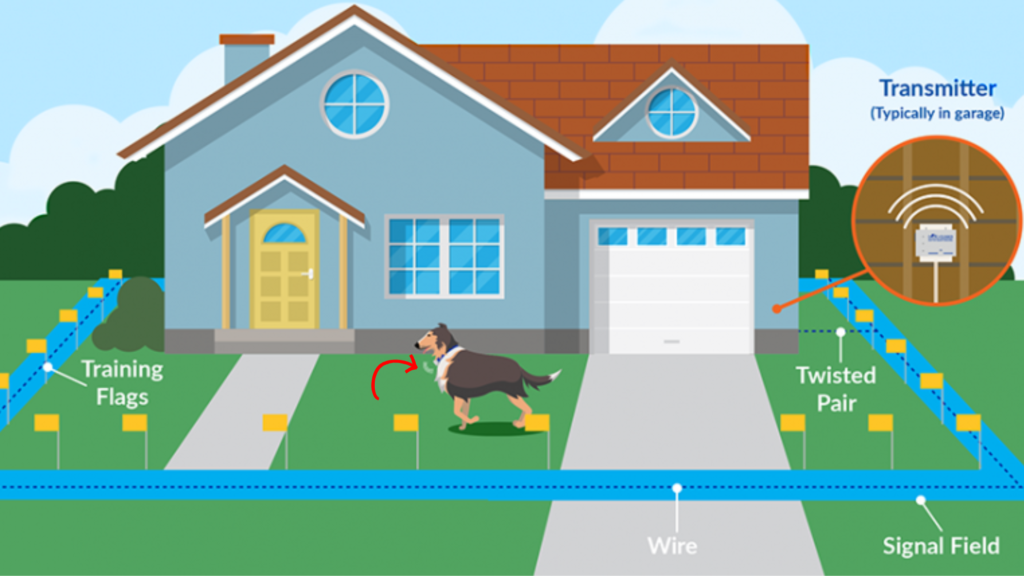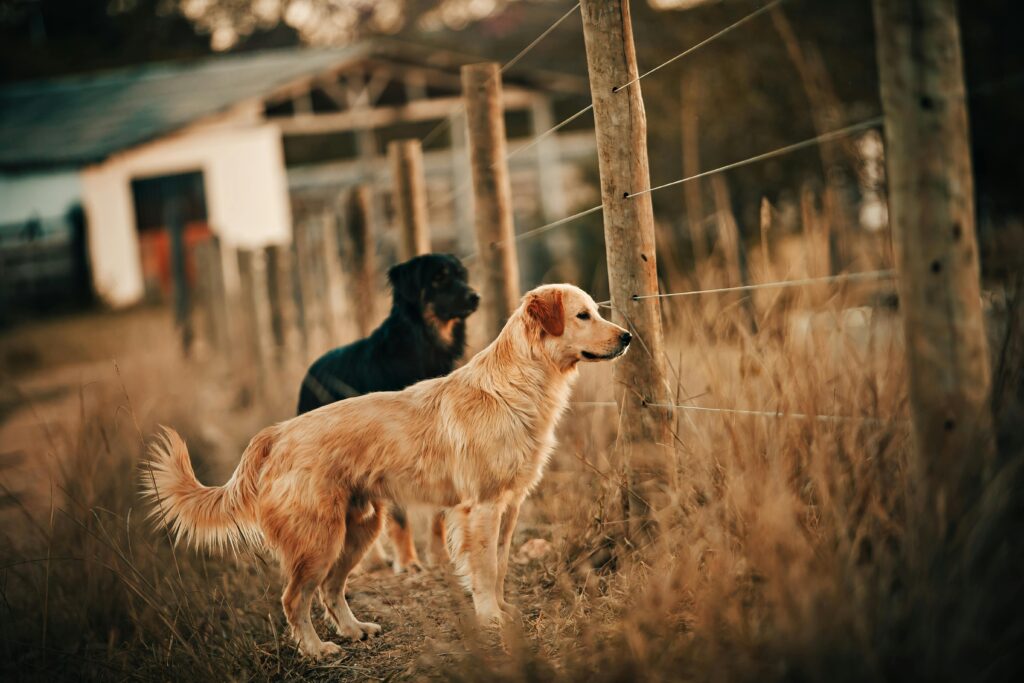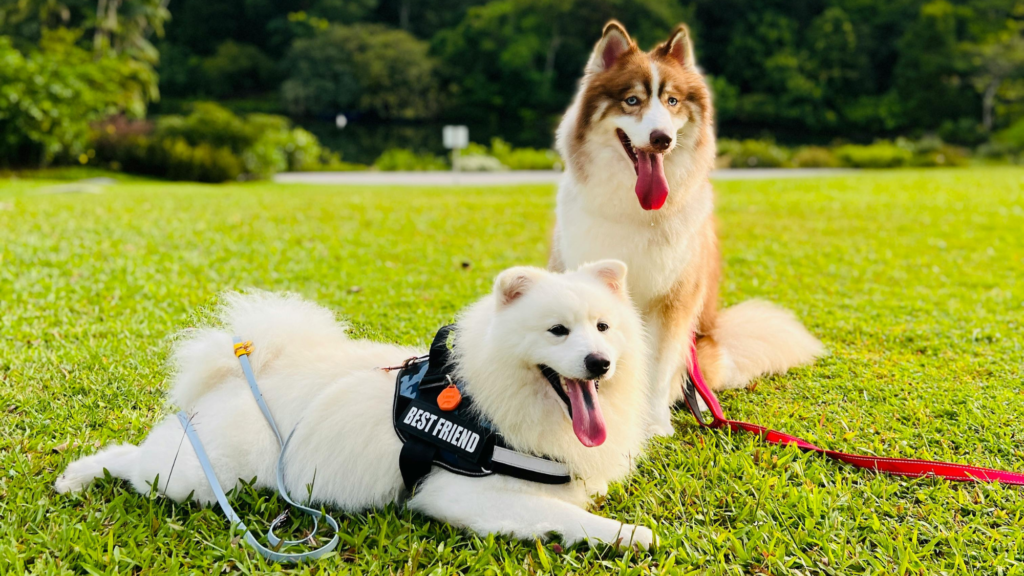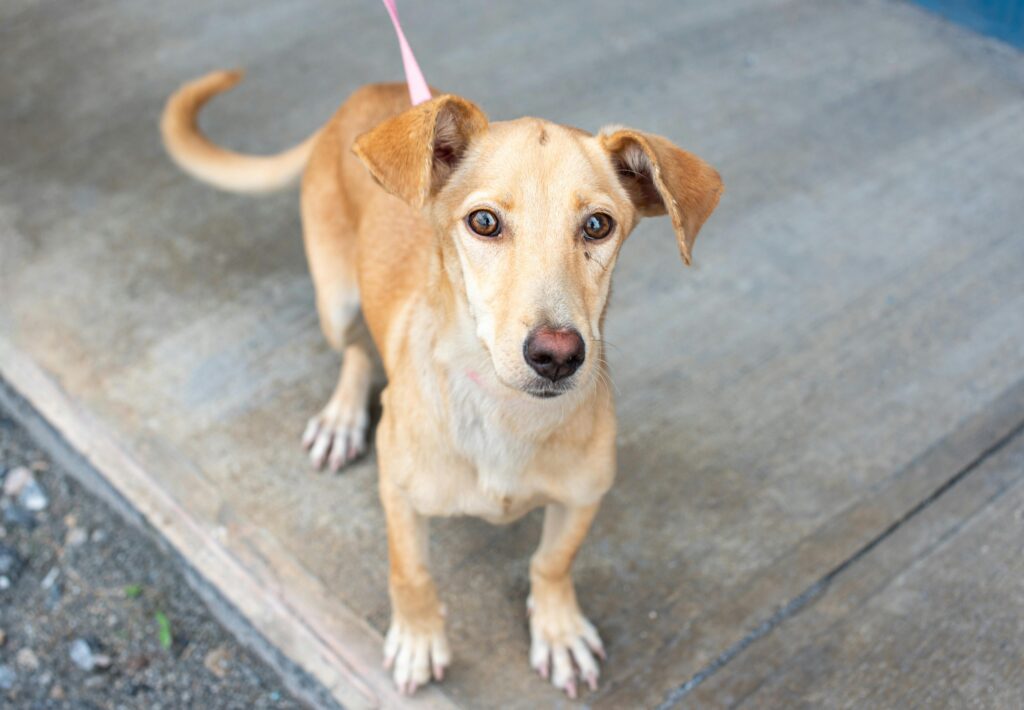| Summary: Invisible fences can be safe with proper training, but risks exist. They don’t prevent external threats, and some dogs may develop anxiety or ignore the correction. Effectiveness depends on training, temperament, and system reliability. Safer alternatives include physical fences and supervised outdoor time. Consider all factors before deciding. |
Invisible fences are a popular choice among pet owners looking to provide their dogs with freedom while maintaining a boundary. These wireless or in-ground containment systems use a combination of buried wires or wireless signals and a receiver collar that delivers a correction (usually a mild electric shock or vibration) if the dog crosses a predetermined boundary. So, is invisible fence safe for dogs?
The primary goal of these systems is to keep dogs from wandering away while eliminating the need for a traditional physical fence, which can be costly and obstructive.
While these fences offer convenience, many pet owners wonder if they are truly safe and humane for their dogs. The idea of using electric correction to train a pet is controversial, with some experts arguing that it can cause stress or behavioral problems.
We will explore the safety of invisible fences, their pros and cons, potential risks, effectiveness, and alternative solutions, helping you make an informed decision. Find the Top-rated Dachshund collars that accommodate their long bodies and prevent strain on their necks.
Blog Highlights
ToggleQuick Fix Table: Is an Invisible Fence Safe for Dogs?
How Do Invisible Fences Work?
Is Invisible Fence Safe for Dogs? Invisible fences use a buried wire or wireless signal to create boundaries, delivering a mild static correction through a collar to keep dogs safely contained.

Is Invisible Fence Safe for Dogs? Invisible fences function using three main components: a transmitter, a receiver collar, and boundary markers. The transmitter is usually installed in the home or yard and sends signals to the receiver collar worn by the dog.
The system is designed to emit a warning tone or vibration when the dog approaches the boundary, giving the pet a chance to retreat before receiving a mild static correction.
To make the training process easier, boundary markers, often in the form of small flags, are placed along the perimeter. These serve as visual cues to help the dog associate the warning signals with specific areas.
Over time, with proper training, dogs learn to stay within the designated safe zone, avoiding the discomfort of the static correction. Get insights into Collar vs. harness for Dachshunds for their safety, comfort, and health during walks.
Is Invisible Fence Safe for Dogs?
An invisible fence can be safe for dogs with proper training, but it has risks. It doesn’t protect from external threats, and some dogs may develop anxiety or ignore the shock. Physical fences or supervised outdoor time are safer alternatives. Effectiveness depends on the dog’s temperament, training quality, and system reliability. Consider all factors before deciding.
1. Physical Safety Considerations
While invisible fences prevent dogs from physically escaping an area, they do not offer the same level of security as a traditional fence. One of the biggest concerns is that a highly motivated dog may ignore the shock and run through the boundary, especially when chasing another animal, reacting to fear, or experiencing excitement.
This can leave the dog stranded outside the safe zone, exposed to dangers like traffic, other animals, or getting lost. To discover what activities bring joy to Australian Cattle Dogs, check out this detailed guide on What Australian Cattle Dogs Enjoy.
Additionally, invisible fences do not protect the dog from external threats. Stray animals, aggressive neighborhood dogs, and even potential thieves can still access the property, putting your pet at risk. Unlike traditional fencing, which provides a physical barrier, invisible fences rely on training and deterrence, which may not always be enough to ensure a pet’s safety.
2. Psychological Impact on Dogs
Invisible fences use aversive conditioning, which means they train dogs through negative reinforcement (a correction is given to prevent unwanted behavior). Some dogs may develop anxiety or fear-based behaviors, especially if they do not fully understand why they are receiving the correction. If training is not handled correctly, a dog may associate random parts of the yard with discomfort, leading to stress and reluctance to move freely.
Another potential issue is confusion and learned helplessness. Dogs that are sensitive to punishment-based training may begin to feel powerless and fearful, particularly if they cannot associate the correction with a specific action.
Over time, this could lead to a decrease in confidence and reluctance to explore, affecting the dog’s overall well-being. To find the ideal collar size for your Australian Cattle Dog, check out this guide on Best Collar Size for Australian Cattle Dog for helpful tips on measurement and fit recommendations
3. Effectiveness of Invisible Fences
For some dogs, invisible fences can be an effective containment method, but their success depends on proper training and consistent use. Dogs must be gradually trained to recognize and respect the boundary using positive reinforcement along with the warning cues. Without proper training, a dog may not fully understand why they are receiving a correction, leading to confusion and distress.
Additionally, a dog’s temperament plays a crucial role in the effectiveness of the fence. Some breeds and personalities respond well to the system, while others, particularly those with strong prey drives, high energy levels, or stubborn tendencies, may find the fence ineffective. A dog that is highly motivated to escape may disregard the correction in favor of pursuing a distraction, which compromises the system’s reliability.
Pros and Cons of Invisible Fences
Pros:
✅ Affordability: Invisible fences are generally less expensive than traditional fencing options, making them an attractive choice for pet owners on a budget. The cost of materials and installation is significantly lower compared to wooden or metal fences, which require ongoing maintenance and repairs.
✅ Aesthetic Appeal: These fences do not obstruct the view of a yard, making them ideal for those who want an open landscape. Traditional fences can sometimes be unsightly or restrictive, while invisible fences maintain the natural beauty of the yard without disrupting its appearance.
✅ Flexibility: They can be installed in various yard layouts, including uneven terrain where physical fences may not be practical. This makes them an excellent option for properties with unique landscapes or large areas where building a traditional fence would be impractical.
✅ Allows Some Freedom: Dogs can roam within set boundaries without being tethered or confined indoors. This provides them with more space to explore and exercise, contributing to their physical and mental well-being.
Cons:
❌ Potential for Psychological Stress: Dogs may develop anxiety or fear-based behaviors, especially if they associate the correction with the yard itself rather than crossing the boundary. This can lead to reluctance to play freely in their own space.
❌ Limited Protection: The fence does not keep other animals or strangers out of the yard, which means dogs are still vulnerable to external threats such as aggressive animals or even theft.
❌ Possible Malfunction: Batteries in receiver collars may fail, or power outages may disable the system. If the fence stops working unexpectedly, the dog may escape without any deterrent, defeating the purpose of the system.
❌ Not Effective for All Dogs: High-prey-drive dogs may ignore the correction and run through the fence. Breeds with a strong instinct to chase, such as hounds or terriers, might not respond well to the deterrent.
❌ Training Requirement: Proper training is essential for the fence to be effective and safe. Without guided training, the system can be ineffective, and the dog may become confused or fearful.
Alternative Solutions to Invisible Fences
Alternative solutions to invisible fences include physical fences, GPS dog collars, and dog playpens. Is Invisible Fence Safe for Dogs? It depends on factors like training, maintenance, and your dog’s temperament.
1. Physical Fencing
A traditional fence is one of the safest ways to keep a dog contained. Wooden, metal, or vinyl fences provide both a physical and visual barrier, protecting dogs from external threats. Unlike invisible fences, these physical barriers prevent interactions with stray animals and protect the dog from external dangers like traffic or unwanted visitors.
While the cost of installation may be higher, physical fences offer long-term security. Many pet owners find them to be a more reliable solution, as they eliminate the risks associated with electronic correction and malfunctioning systems.

2. Supervised Outdoor Time
Allowing dogs outside only under supervision ensures their safety and prevents them from wandering off. By keeping an eye on your pet, you can intervene if they attempt to escape or encounter an external threat.
Supervised outdoor time also promotes healthy socialization, allowing pet owners to interact with their dogs while providing enrichment activities such as fetch, training exercises, or puzzle toys.

Find out Best collar colors for Rottweilers to complement their bold appearance and highlight their unique features.
Training Your Dog for an Invisible Fence: A Step-by-Step Guide
Training is essential for an invisible fence to be effective and safe. Without proper instruction, dogs may become confused, anxious, or fail to respect the boundaries. A well-trained dog will understand the warning signals and know how to stay within the designated area. Here’s a step-by-step guide to successfully training your dog to use an invisible fence.
Step 1: Setting Up the Training Environment
Before training begins, it’s important to prepare the environment. Start by placing boundary flags around the perimeter where the invisible fence has been installed. These flags serve as a visual aid for the dog to learn where the boundary is located.
Additionally, ensure that the receiver collar is properly fitted. The collar should be snug but not too tight, allowing for two fingers to fit between the strap and the dog’s neck. Always test the collar beforehand to ensure that it is functioning correctly and emitting the proper warning signals.
Step 2: Introducing Your Dog to the Boundary
The first few training sessions should focus on helping the dog recognize the boundary without any correction. With your dog on a leash, walk towards the boundary flags and allow them to see and sniff them. When the receiver collar emits a warning beep, immediately turn around and guide the dog back into the safe zone.
Use positive reinforcement, such as treats and praise, to reward your dog for responding correctly. The goal of this step is to teach the dog that the warning beep means they should stop and retreat from the boundary. Repeat this exercise several times per session over the course of a few days.
Step 3: Adding the Correction
Once the dog consistently responds to the warning beep, it’s time to introduce the static correction. Set the receiver collar to the lowest correction level and approach the boundary as before. If the dog does not retreat after hearing the warning beep, they will receive a mild static correction.
It’s important to remain calm and supportive. If the dog reacts fearfully, offer reassurance and guide them back into the safe zone. Do not allow the dog to associate the yard itself with discomfort. Instead, reinforce the idea that staying within the boundary is positive and rewarding.
Step 4: Practicing Off-Leash Training
After your dog reliably responds to the warning beep and static correction while on a leash, begin off-leash training in a controlled manner. This step should be done in short sessions, with careful monitoring. Encourage the dog to explore the yard while keeping an eye on their reactions to the boundary.
If the dog approaches the flagged area, use voice commands and positive reinforcement to encourage them to retreat. Keep distractions to a minimum during these early sessions to help them focus on learning the boundaries.
Step 5: Introducing Distractions
Once your dog is comfortable with the boundaries, begin adding distractions to test their response. Use toys, treats, or other pets to gauge whether your dog remains within the safe zone despite temptations. Some dogs may need extra reinforcement if they are prone to chasing animals or reacting to external stimuli.
If your dog attempts to cross the boundary, redirect them back to the safe zone and reinforce training with positive encouragement. Continue practicing until they consistently respect the limits, even when distractions are present.
Step 6: Gradual Removal of Boundary Flags
After a few weeks of consistent training, the boundary flags can be gradually removed. Remove a few flags each day, ensuring that your dog still respects the invisible boundary. By this stage, the dog should rely on the warning beep rather than visual cues to understand where they should stop.
Monitor your dog closely during this transition period to ensure they remain within the designated area. If they show signs of confusion, temporarily replace the flags and extend the training duration.

Common Training Challenges and Solutions
1. Dog Becomes Fearful of the Yard
Some dogs may become anxious or avoid the yard after experiencing a correction. To counteract this, engage in positive activities such as playtime and treats within the safe zone to build a positive association.

2. Dog Ignores the Static Correction
Highly motivated dogs may ignore the correction and run through the boundary. If this happens, increase training sessions, reinforce voice commands, and consider raising the correction level slightly if necessary.
3. Dog Becomes Overly Dependent on Flags
If a dog only respects the boundary when flags are present, extend the training period before removing them. Use additional reinforcement techniques such as verbal cues to strengthen their understanding of the boundary.
Final Verdict: Is Invisible Fence Safe for Dogs?
While invisible fences can be a convenient containment solution for some pet owners, they are not the safest or most effective option for all dogs. The safety of an invisible fence depends on factors such as training, the dog’s temperament, and proper system maintenance. Hope so, now you know, is invisible fence safe for dogs?
For pet owners considering an invisible fence, it is crucial to invest in proper training to ensure the dog understands the boundaries. Additionally, monitoring the dog’s behavior for signs of stress and using additional safety measures such as supervised playtime or GPS tracking can enhance security.
Ultimately, if safety is the top priority, a physical fence, supervised outdoor time, or GPS-based containment system may provide a more reliable and stress-free solution for keeping dogs secure. Check out the Perfect collars for Border Collies to find durable, stylish, and comfortable options for your active dog.





